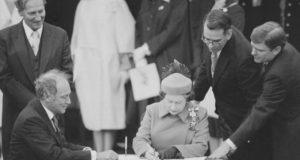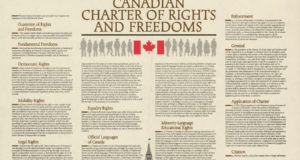The Court of Appeal for Ontario recently delivered a noteworthy decision regarding the scope and limits of the constitutional protection for freedom of expression, Bracken v Town of Fort Erie, 2017 ONCA 668. The decision, written by Justice Miller for a unanimous court, breaks no new ground, but contains clear and cogent reminders of two elementary principles that, sadly, may not be self-evident in 2017: violence is not a constitutionally protected form of expression; but words, even spoken in anger, and even if those who hear them are, subjectively, feeling unsafe as a result, are not violence.
The case arose out of Mr Bracken’s solitary, but perhaps somewhat agitated, protest in the parking lot in front of the Town Hall against a decision the municipal council was about to make. Employees of the Town, one of whom had had a rather unpleasant interaction with Mr Bracken in the past, felt worried enough by what they perceived as erratic and threatening behaviour on his part that they called the police, who arrested Mr Bracken and served him with a Trespass Notice banning him from the Town Hall and two other municipal properties. The question for the courts was whether this contravened Mr Bracken’s freedom of expression. The Superior Court said “no”, on the basis that the expression in question was violent. The Court of Appeal disagreed.
* * *
After noting that the protection for freedom of expression, which Canadian courts recognized even before the entrenchment of the Canadian Charter of Rights and Freedoms is broad, Justice Miller explains why violence nevertheless falls outside the scope of this protection, although “some might find it difficult to understand the rationale for excluding violence categorically”. [30] “Violence and force”, he points out, “are predicated on the denial that persons are equal in dignity, negating the reciprocity necessary for communication and genuine dialogue”. [28] To treat prohibitions on violence as in need of justification
would be tantamount to declaring that Canadian constitutional morality is open to the proposition that an individual’s self-expression through acts of violence could, in some conceivable circumstances, take priority over the public good of protecting persons by restraining acts of violence. [30]
But how far does the exclusion of violence from the scope of the constitutional protection of freedom of expression extend? Justice Miller notes that it has been held to apply to actual physical violence and to threats of such violence, “on the basis that a person who threatens violence takes away free choice and undermines freedom of action” just as surely as one who commits violence. [31] But there was no evidence that Mr Bracken had engaged in any such behaviour. The Town employees who felt threatened by him had “observed him ‘from a safe distance’”. [37] One of them testified that she had “never had a conversation with” Mr Bracken prior to the court proceedings. [43] In short, Justice Miller concludes, “[t]he employees were indeed frightened, but the evidence does not disclose any reasonable basis for their fear.” [46]
Since Mr Bracken was not violent, his protest was protected by the Charter‘s guarantee of freedom of expression. The trespass notice banning him from the Town’s property was an infringement of his freedom, and one that cannot be justified under section 1 of the Charter. This is primarily because the Town’s action in banning Mr Bracken did not pursue a valid objective:
the factual basis on which [the Town] issued the trespass notice was largely erroneous. Mr. Bracken was not engaged in any violent activity. He was not blocking anyone. He was not preventing anyone from accessing the building. His behaviour was neither intimidating, in any relevant sense of the word, nor erratic. The Town employees, both junior and senior, were alarmed, but they were alarmed too easily. … If anyone felt intimidated by him, other than Town employees who had never before witnessed a protest and doubted that protests in front of Town Hall were lawful, it was not because he was threatening anyone. [76]
Besides, the trespass notice was much too broad; a disruptive or threatening protester might be asked to leave or, if need be, expelled, but that does not justifying banning him from public property for a whole year.
* * *
I’ll make a couple of observations about Justice Miller’s reasons. One is that they are at once unique, in the sense that a different judge would probably have written noticeably differently, and perfectly orthodox. I doubt many judges would have cited Joseph Raz (as Justice Miller does in describing “[t]he rule against violence [as] an exclusionary rule: it excludes by kind and not by weight”), or perhaps even Grégoire Webber’s The Negotiable Constitution: On the Limitation of Rights. Nor would many have spoken of “a set of human goods thought to be advanced by a constitutional protection of freedom of expression” [26; emphasis mine], using a phrase drawn from natural law theory. (The Supreme Court usually speaks of values or purposes instead.) But Justice Miller’s conclusions are those that the vast majority of Canadian judges would, I would like to hope, reach when presented with a similar case. (Of course, the trial judge reached the opposite conclusion, which is not altogether reassuring.) And as for the natural law allusion, though it might upset Sean Fine (who was much exercised by Justice Miller’s interest in natural law at the time of Justice Miller’s promotion to the Court of Appeal), Justice Miller shows that it too is more orthodox than Mr. Fine might realize, by referring to Justice Rand’s remark in Saumur v. City of Quebec, [1953] 2 SCR 299 that
freedom of speech, religion and the inviolability of the person are original freedoms which are at once the necessary attributes and modes of self-expression of human beings and the primary conditions of their community life within a legal order. (329)
(While I’m at it, can I gratuitously put in a plug for a post I wrote a earlier this year about a Québec Court of Appeal decision from the ’50s where natural law played an even more important role?)
The second observation I wanted to make here is that, although he decides the case under the Charter, the way it was argued by Mr. Bracken (who was representing himself), Justice Miller points out that administrative law reasons may well have supported an identical outcome. He notes that
a preliminary question … was never addressed: whether the Town’s expulsion of Mr. Bracken from the premises and the issuance of the trespass notice was lawful in the circumstances. … [Addressing it] may have obviated the need for a Charter analysis, and would have brought to the fore the issue of the implied limits on the common law authority of government actors to exclude persons from public property. [24]
Justice Miller adds
that where a government issues a trespass notice relying on the common law power to expel persons from property, it is exercising a power that is subject to implied limits. It cannot be issued capriciously; that is, it cannot be issued, in the circumstances of a public protest in the town square, without a valid public purpose. [75]
This matters, not just out of legal pedantry, but because one important actor that may well find itself involved in controversies about freedom of expression, protests, and violence real or imaginary might not be subject to the Charter: universities. Yet while the applicability of the Charter to them remains a murky question, it is clear that their decisions can in appropriate circumstances be subject to judicial review. Justice Miller’s reasons reinforce the point, already made by a majority of the Alberta Court of Appeal in Pridgen v University of Calgary, 2012 ABCA 139, that freedom of expression is an important consideration for such proceedings.
* * *
This brings me to the last issue I want to address: how Justice Miller’s opinion fits into not just the legal, but the broader social context of 2017. This context is marked by the presence of two most unfortunate, and seemingly contradictory, beliefs: on the one hand, that “punching nazis”—and, inevitably, any number of other people—is permissible, and perhaps commendable; on the other, that some words—perhaps “hate speech” more or less narrowly defined, and perhaps some broader category of politically incorrect expression—are tantamount to violence and should be excluded from the scope of protection normally granted freedom of expression. (Richard Epstein provides a cogent rebuttal of that view in this Wall Street Journal article.)
Although they seem incoherent if not mutually exclusive, these twin beliefs work together to blur, indeed to erase, the line between the concepts of expression and violence. What one says, or does, is expression; what one’s opponents say, or do, is violence. And, as Lewis Carroll knew, the ability to make words mean whatever different things one chooses them to mean, neither more nor less, is a matter of “who is to be master”.
Justice Miller’s opinion resolutely pushes back against both of these pernicious ways of thinking. It explains why “punching Nazis” is never permissible—doing it means refusing to treat them as human beings (which, of course, is what Nazis themselves were notorious for). But it also insists that hurt feelings, or purely subjective claims of intimidation cannot be re-labelled as allegations of violence to shut down speech or protest, even when it takes on an unpleasant form:
Violence is not the mere absence of civility. The application judge extended the concept of violence to include actions and words associated with a traditional form of political protest, on the basis that some Town employees claimed they felt “unsafe”. This goes much too far. A person’s subjective feelings of disquiet, unease, and even fear, are not in themselves capable of ousting expression categorically from the protection of s. 2(b) [of the Charter].
The consequences of characterizing an act as violence or a threat of violence are extreme: it conclusively defeats the Charter claim without consideration of any other factor. Accordingly, courts must be vigilant in determining whether the evidence supports the characterization, and in not inadvertently expanding the category of what constitutes violence or threats of violence.
… A protest does not cease to be peaceful simply because protestors are loud and angry. Political protesters can be subject to restrictions to prevent them from disrupting others, but they are not required to limit their upset in order to engage their constitutional right to engage in protest. [49-51]
Justice Miller thus provides a very timely statement of the orthodox principles of freedom of expression in the public square. It would be nice if not only his fellow judges, but also others in positions of authority—in governments at every level, in universities, and elsewhere—as well as those tempted to take authority in their own hands, or fists, read his opinion and took it to heart. We would be a freer and more respectful society if they did.
This article was originally published on Double Aspect, Professor Sirota’s award-winning blog.
 Advocates for the Rule of Law
Advocates for the Rule of Law



